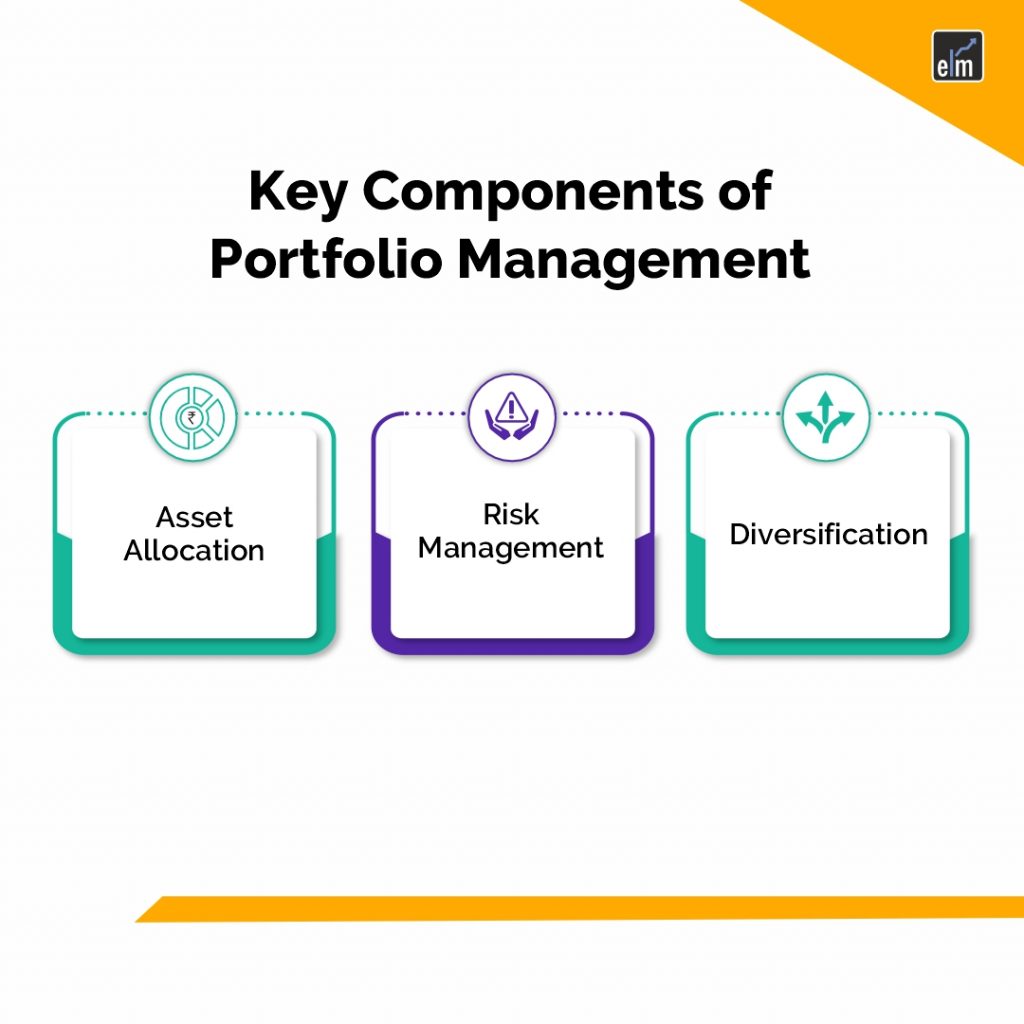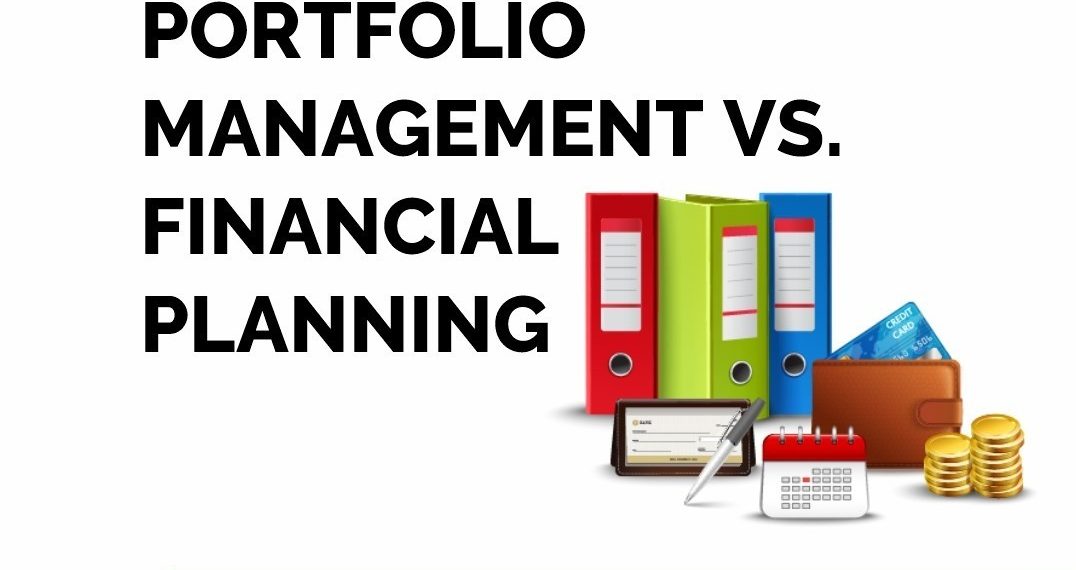Comprehending many essential ideas, such as financial planning and portfolio management, is necessary for efficient money management. Despite their frequent interchangeability, these terms refer to different aspects of financial health.
Creating, funding, and managing a collection of financial assets, including stocks, bonds, mutual funds, and more, is the core goal of portfolio management.
Investment management is only one aspect of financial planning. It entails drafting a thorough plan of action to reach your short- and long-term financial objectives.
Portfolio management concentrates on the individual investments you own, whereas financial planning takes into account your entire financial situation and well-being. Achieving your financial objectives and safeguarding your financial future depend on both.
In today’s blog, let us understand the difference between portfolio management and financial planning-
Table of Contents
What is Portfolio Management?
For the benefit of investors or institutions, portfolio management is managing a group of investments together, or a portfolio, in order to achieve certain financial objectives.
The art and science of portfolio management involves choosing an appropriate investment mix and policy, allocating assets to individuals and organizations, and striking a balance between performance and risk.
It includes a broad range of actions and factors meant to maximize investment returns while controlling risk in accordance with the objectives and limitations of an investor.
Optimizing returns, controlling risk, attaining diversification, and matching investments to investor goals and limitations are the main goals of portfolio management.
Diverse tactics and methods, including asset allocation, diversification, active and passive management, tactical and strategic asset allocation, and market timing strategies, are used in portfolio management.
Key Components of Portfolio Management
The key components of Portfolio Management are as follows:

Asset Allocation
Determining the ideal combination of asset types, such as stocks, bonds, cash, and alternative assets, for a portfolio is known as asset allocation. The choice of allocation is influenced by a number of variables, including the investor’s time horizon, investing goals, and risk tolerance.
Through diversifying assets over several asset classes that have traditionally shown little correlation to one another, asset allocation seeks to strike a balance between risk and return.
Risk Management
The process of recognizing, evaluating, and reducing the several kinds of risk that might affect the value of investments in a portfolio is known as risk management. Among other things, these risks could be related to markets, credit, liquidity, interest rates, inflation, and geopolitics.
Portfolio managers utilize a range of risk management strategies, including asset-liability matching, hedging, diversification, and the use of derivatives, to reduce the possibility that unfavorable events may negatively affect the performance of the portfolio.
Diversification
As a risk management strategy, diversification entails distributing investments over a range of assets, asset classes, sectors, industries, and geographical areas.
Through the mitigation of unfavourable events that could harm any one investment or asset class, diversification aims to lower the portfolio’s overall risk. By lessening the portfolio’s susceptibility to particular market or industry downturns, diversification can assist in increasing portfolio stability and possibly improve long-term returns.
The Role of Portfolio Managers
Portfolio managers are essential when it comes to managing investment portfolios for people, organizations, or funds. They are responsible for making strategic decisions on risk management, security selection, and asset allocation.
They use economic data, market trends, and business fundamentals to create well-informed financial decisions that help clients reach their goals. Portfolio managers keep a close eye on the performance of their holdings and allocations, making appropriate adjustments to optimize returns while controlling risk within predetermined bounds.
In order to ensure alignment with client goals and market dynamics, they must also adhere to regulatory standards, communicate effectively with clients, and stay up to date on market trends.
What is Financial Planning?
The process of graphing your financial future and acting to reach your objectives is known as financial planning. It’s similar to making a plan that takes your goals, income, spending, and risk tolerance into account. It includes:
- Setting goals-Including purchasing a home and retiring comfortably.
- Creating a budget- Monitoring your income and outgoings to make wise financial decisions.
- Investing strategically-Selecting appropriate investments to increase your wealth.
- Protecting yourself- Including making plans for unforeseen events like illness or emergencies.
- Planning for the future-Including long-term care and estate planning.
As your life and goals evolve, financial planning is dynamic and personal. It gives you the ability to reach financial security and make wise financial decisions.
What are the Components of Financial Planning?
The key components of Financial Planning are as follows:

- Budgeting and Saving: Creating a budget promotes financial stability and goal achievement by helping to control spending and allocate money for investments and savings.
- Investment planning is the process of creating an investment strategy to increase wealth and provide returns over time that is based on a person’s time horizon, financial objectives, and risk tolerance.
- Retirement planning, which frequently involves retirement accounts, pensions, and other investment vehicles, is the process of determining and saving money to maintain a desired lifestyle after retirement.
- Tax planning is the process of maximizing tax efficiency by using tax-advantaged accounts, credits, and deductions to reduce taxable income.
- Insurance planning is evaluating one’s needs for liability, property, health, and life insurance in order to reduce risk and guard against unanticipated circumstances.
- Estate planning is the process of allocating assets and transferring wealth to beneficiaries or heirs in a way that minimizes tax consequences and legal entanglements.
Importance of Financial Planning in Personal Finance
Financial planning is crucial in personal finance as it provides a roadmap for achieving financial goals and securing one’s future. It helps individuals manage income, expenses, and investments effectively, ensuring financial stability and security.
Through strategic budgeting, saving, and investment allocation, financial planning empowers individuals to build wealth, prepare for retirement, and handle unforeseen expenses or emergencies.
It also facilitates informed decision-making, enabling individuals to make sound choices about spending, borrowing, and investing based on their unique circumstances and aspirations. Ultimately, financial planning empowers individuals to take control of their finances, reduce financial stress, and work towards a more secure and prosperous future.
The Role of Financial Planners
When it comes to helping people and families reach their financial goals, financial planners are essential. To create individualized financial plans, they evaluate their clients’ objectives, risk tolerance, and financial circumstances.
They assist customers in making decisions that will maximize their financial results by drawing on their knowledge in fields including investment management, tax planning, retirement planning, and estate planning.
To ensure that plans are in line with changing market conditions and aspirations, financial planners offer continuous monitoring and plan changes. Their unbiased advice and customized tactics enable customers to manage intricate financial environments, reduce hazards, and strive for financial stability and success.
What are the Key Differences Between Portfolio Management and Financial Planning
The main differences between Portfolio Management and Financial Planning are as follows:
Focus and Scope
- The main goals of portfolio management are to control risk and maximize returns on investment.
- A wider range of personal financial management is covered by financial planning, which includes extensive analysis and planning for budgeting, savings, investments, retirement planning, insurance, estate planning, and tax preparation, among other areas.
Time Horizon
- With a shorter time horizon, portfolio management usually concentrates on the performance of investments inside a particular portfolio.
- Financial planning takes into account long-term financial goals and objectives, like wealth transfer and retirement planning, which frequently span several decades.
Client Base
- Fund managers, institutional investors, and individual investors who want to optimize portfolio returns often benefit from portfolio management.
- Financial planning aims to address the larger financial needs and goals of people, families, and even businesses.
Objectives
- The main purpose of portfolio management is to optimize investment returns while controlling risk in accordance with the objectives and limitations of the investor.
- The goal of financial planning is to assist people in reaching a variety of financial objectives, such as risk management, estate planning, retirement planning, and asset growth.
Tools and Techniques Utilized
- To maximize portfolio performance, portfolio management approaches include investment analysis, asset allocation, security selection, and risk management.
- To create thorough financial plans, financial planners use cash flow management, insurance analysis, tax optimization strategies, estate planning tools, and retirement income planning procedures.
Regulatory Considerations
- Regulations pertaining to risk disclosure, investment management procedures, and fiduciary duties apply to portfolio management.
- Financial planning may include following industry rules such as those set forth by the Securities and Exchange Commission (SEC) or the Financial Industry Regulatory Authority (FINRA), as well as laws governing financial advising such as licensing requirements and fiduciary standards.
Synergies Between Portfolio Management and Financial Planning
Here are Synergies Between Portfolio Management and Financial Planning-
Alignment of Goals
Financial planning and portfolio management both seek to assist people in reaching their financial goals. Individuals can make sure that their investment portfolios are customized to match their unique requirements and goals by matching their investment strategies with more general financial goals that are determined through the financial planning process.
Holistic Approach to Wealth Management
A more comprehensive approach to wealth management is made possible by integrating portfolio management with financial planning. People can take into account all aspects of their financial situation, such as risk management, cash flow management, tax planning, retirement objectives, and estate planning, rather than only concentrating on investment returns. This all-encompassing viewpoint facilitates better decision-making and financial resource efficiency.
Integration of Strategies
Financial planning techniques and portfolio management techniques can be combined to produce coherent and effective financial plans. Financial plans can be used to design investment strategies that are tailored to each person’s specific risk tolerance, time horizon, and liquidity requirements.
Individuals can maximize their chances of long-term success and wealth creation by pursuing their financial objectives in a coordinated and effective manner by integrating investing decisions with more general financial planning concerns.
Conclusion
To summarize, Financial Planning adopts a comprehensive strategy to handle more general financial goals and demands, whereas Portfolio Management concentrates on maximizing investment returns and controlling risk within investment portfolios. Because they offer specialized techniques that are in keeping with each person’s goals and financial situation, both disciplines are crucial to wealth management.
Frequently Asked Questions (FAQs)
What is the primary focus of Portfolio Management compared to Financial Planning?
Investment portfolio risk management and return optimization are the main objectives of portfolio management, whereas financial planning takes a more comprehensive approach to financial needs and goals.
How does the time horizon differ between Portfolio Management and Financial Planning?
The time horizon for portfolio management is usually shorter than that of financial planning, which takes into account long-term financial goals and objectives that can span many decades.
What are the key components of Portfolio Management and Financial Planning?
While financial planning covers budgeting, saving, investment planning, retirement planning, tax planning, insurance planning, and estate planning, portfolio management concentrates on asset allocation, risk management, and diversification.
For Market Updates, Visit StockEdge







